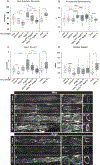The nutrient sensor CRTC and Sarcalumenin/thinman represent an alternate pathway in cardiac hypertrophy
- PMID: 39093699
- PMCID: PMC11402474
- DOI: 10.1016/j.celrep.2024.114549
The nutrient sensor CRTC and Sarcalumenin/thinman represent an alternate pathway in cardiac hypertrophy
Abstract
CREB-regulated transcription co-activator (CRTC) is activated by Calcineurin (CaN) to regulate gluconeogenic genes. CaN also has roles in cardiac hypertrophy. Here, we explore a cardiac-autonomous role for CRTC in cardiac hypertrophy. In Drosophila, CRTC mutants exhibit severe cardiac restriction, myofibrillar disorganization, fibrosis, and tachycardia. Cardiac-specific CRTC knockdown (KD) phenocopies mutants, and cardiac overexpression causes hypertrophy. CaN-induced hypertrophy in Drosophila is reduced in CRTC mutants, suggesting that CRTC mediates the effects. RNA sequencing (RNA-seq) of CRTC-KD and -overexpressing hearts reveals contraregulation of metabolic genes. Genes with conserved CREB sites include the fly ortholog of Sarcalumenin, a Ca2+-binding protein. Cardiac manipulation of this gene recapitulates the CRTC-KD and -overexpression phenotypes. CRTC KD in zebrafish also causes cardiac restriction, and CRTC KD in human induced cardiomyocytes causes a reduction in Srl expression and increased action potential duration. Our data from three model systems suggest that CaN-CRTC-Sarcalumenin signaling represents an alternate, conserved pathway underlying cardiac function and hypertrophy.
Keywords: CP: Cell biology; CP: Metabolism; CRTC; Calcineurin; Drosophila; Sarcalumenin; cardiac; fibrosis; hiPSC-cardiomyocytes; hypertrophy; thinman; zebrafish.
Copyright © 2024 The Author(s). Published by Elsevier Inc. All rights reserved.
Conflict of interest statement
Declaration of interests The authors declare no competing interests.
Figures







Update of
-
The nutrient sensor CRTC & Sarcalumenin / Thinman represent a new pathway in cardiac hypertrophy.bioRxiv [Preprint]. 2023 Oct 2:2023.10.02.560407. doi: 10.1101/2023.10.02.560407. bioRxiv. 2023. Update in: Cell Rep. 2024 Aug 27;43(8):114549. doi: 10.1016/j.celrep.2024.114549. PMID: 37873259 Free PMC article. Updated. Preprint.
References
Publication types
MeSH terms
Substances
Grants and funding
LinkOut - more resources
Full Text Sources
Molecular Biology Databases
Research Materials
Miscellaneous

